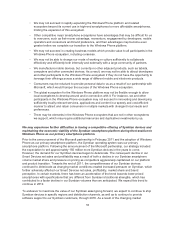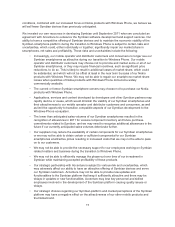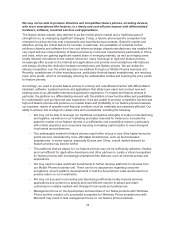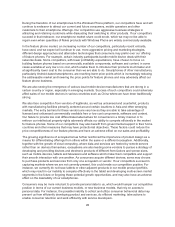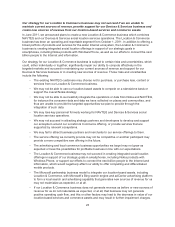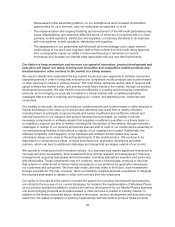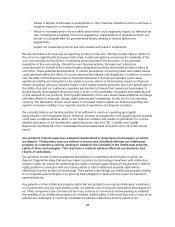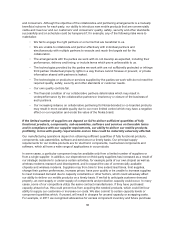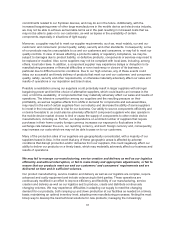Nokia 2011 Annual Report Download - page 23
Download and view the complete annual report
Please find page 23 of the 2011 Nokia annual report below. You can navigate through the pages in the report by either clicking on the pages listed below, or by using the keyword search tool below to find specific information within the annual report.A key component of our current strategy is investment in future disruptive technologies, including
investment in longer-term market exploration of next-generation devices, platforms and user
experiences. Additionally, we continuously seek new business and monetization models. Certain of our
competitors have significant resources to invest in market exploration and seek new monetization
models or drive industry development and capture value in areas where we are not competitive. Those
areas can be, for instance, monetization models linked to the use of large amounts of consumer data,
large connected communities, home entertainment services and alternative payment mechanisms. We
may not be able to invest our own resources to compete in these areas, which may in the future prove
a competitive disadvantage for us. If we fail in these aspects of our strategy, we may not realize a
return on our investments or may incur operating losses and impair our competitiveness for the
longer-term.
With respect to digital map data and related location-based content, several global and local
companies, as well as governmental and quasi-governmental agencies, are making more map data
with improving coverage and content, and high quality, available free of charge or at lower prices. For
example, our Location & Commerce business competes with Google which uses an advertising-based
model allowing consumers and companies to use its map data and related services in their products
free of charge to consumers. Google has continued to leverage Google Maps as a differentiator for
Android bringing certain new features and functionality to that platform. Apple has also sought to
strengthen its location assets and capabilities through targeted acquisitions and organic growth.
Location & Commerce also competes with companies such as TomTom, which licenses its map data
and where competition is focused on the quality of the map data and pricing, and Open Street Map,
which is a community-generated open source map available to users free of charge. Aerial, satellite
and other location-based imagery is also becoming increasingly available and competitors are offering
location-based products and services with the map data to both business customers and consumers in
order to differentiate their offerings. Those developments may encourage new market entrants, cause
business customers to incorporate map data from sources other than our Location & Commerce
business or reduce the demand for fee-based products and services which incorporate Location &
Commerce map database. Accordingly, our Location & Commerce business must positively
differentiate its digital map data and related location-based content from similar offerings by our
competitors and create competitive business models for our customers.
We may not be able to retain, motivate, develop and recruit appropriately skilled employees,
which may hamper our ability to implement our strategies, particularly our current mobile
products strategy and location-based services and commerce strategy, and we may not be able
to effectively and smoothly implement the new operational structure for our businesses,
achieve targeted efficiencies and reductions in operating expenses.
We announced a new strategy, leadership team and operational structure for our Devices & Services
business on February 2011 designed to focus on speed, results and accountability. In June 2011, we
announced plans to create a new Location & Commerce business which combines NAVTEQ and our
Devices & Services social location services operations, which became operational from October 1,
2011. The implementation of these strategies and changes in operational structure are expected to
have a significant impact on our operations and personnel, including substantial reductions in
personnel following the appropriate consultations. Additionally, reorganizations and restructurings
result in cash outflows related to such activities, as well as restructuring charges and associated
impairments. We have made announcements in 2011 and 2012 concerning planned personnel
reductions, outsourcing, plans to align our site operations, plans to change our manufacturing
operations and to reconfigure certain of our European and Americas manufacturing facilities and adjust
our manufacturing capacity. Additionally, in November 2011 Nokia Siemens Networks announced
plans for a strategic shift and restructuring targeted to maintain long-term competitiveness and improve
profitability discussed below under risks primarily related to Nokia Siemens Networks.
21







